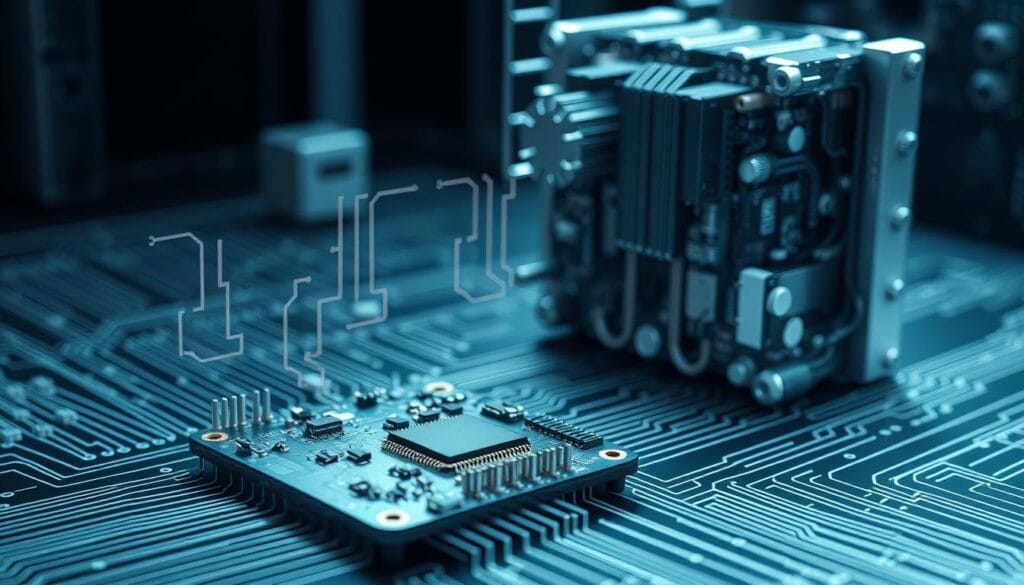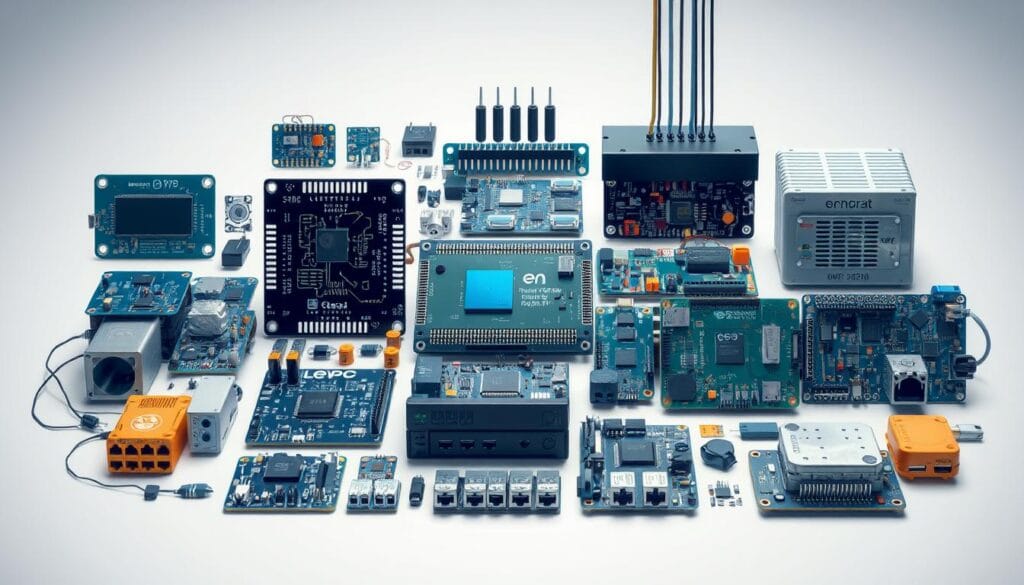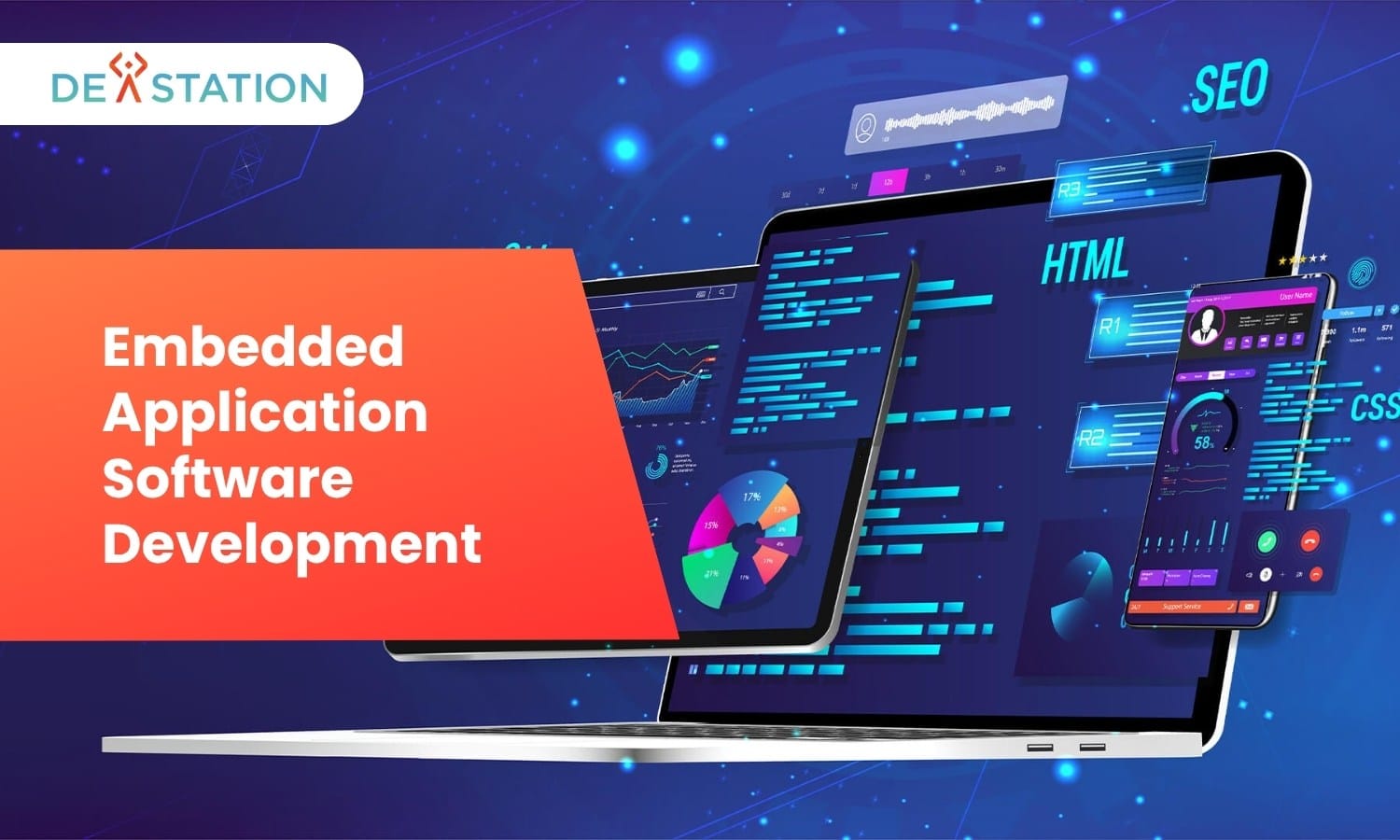Modern technology relies on specialized programs that power everyday devices—from medical equipment to smart home gadgets. These systems operate behind the scenes, combining precise code with physical components to deliver reliable performance. Unlike standard computer programs, they’re designed for specific tasks, often with strict limits on processing speed and memory usage.
What makes embedded software unique? It’s tightly integrated with hardware, creating solutions tailored for industries like automotive and healthcare. Developers must account for real-time operations and energy efficiency, ensuring devices function flawlessly under demanding conditions.
Business leaders recognize the growing importance of these technologies across sectors. From connected factories to wearable health monitors, optimized systems drive innovation while meeting rigorous performance standards. This guide unpacks the strategies and expertise required to build robust solutions in this evolving field.
Contents
ToggleIntroduction to Embedded Application Software Development
From your morning coffee maker to life-saving hospital equipment, tailored digital brains make it all possible. These specialized programs operate silently within physical devices, combining precise code with hardware to perform specific tasks efficiently. Unlike desktop programs, they’re built for reliability under strict constraints like limited memory and processing power.
Overview of Embedded Systems
Embedded systems are dedicated computing platforms designed for single functions within larger machines. They process data in real time—think traffic light controllers adjusting to congestion or wearables tracking heart rates. Modern versions now handle complex tasks like voice recognition in smart speakers, thanks to advanced architectures blending connectivity with decision-making capabilities.
Importance in Today’s Technology Landscape
Over 98% of microprocessors sold today power embedded devices, driving innovations across industries. Factory robots optimize production lines, while medical implants monitor patients autonomously. These systems form the backbone of smart cities and IoT networks, enabling devices to adapt through AI and edge computing. Businesses leveraging this technology gain competitive advantages through enhanced product performance and energy efficiency.
Developers face unique challenges here, balancing hardware limitations with software optimization. Success requires expertise in low-level programming and system design—skills that transform theoretical concepts into real-world solutions.
Core Concepts of Embedded Software and Systems

The magic of today’s devices comes from the precise collaboration between programmed logic and hardware elements. This partnership determines how efficiently a gadget operates, balancing computational power with physical constraints. To build reliable solutions, developers must grasp how these two domains interact and influence each other’s design.
Defining the Partnership: Code and Circuitry
Embedded software acts as the brain of a device, delivering instructions to components like microcontrollers and sensors. In contrast, the system represents the entire ecosystem—physical parts working with programmed commands. For example, a smart thermostat’s temperature adjustments rely on code optimized for its specific processor and memory limits.
Designers face a critical challenge: creating software that aligns perfectly with pre-selected hardware. Choices made during development—such as communication protocols or power management—directly impact performance. A fitness tracker’s heart rate monitor, for instance, needs code that processes data quickly without draining the battery.
Modern solutions often stack multiple software layers. Firmware handles low-level operations, while middleware bridges hardware and user-facing features. This structure allows updates and customization without redesigning entire systems. By understanding these relationships, teams can allocate resources effectively and ensure long-term reliability.
Key Components and Architecture of Embedded Systems

Efficient devices rely on carefully designed internal structures. These architectures combine physical parts with programmed logic to deliver targeted functionality. Let’s explore the building blocks that make these solutions work.
Hardware Essentials and Flash Memory
Every system starts with core components. Power circuits ensure stable energy flow, while timers manage operations. Flash memory plays a critical role—it stores code permanently, even during power loss. This makes it ideal for medical devices needing reliable data retention.
| Component | Function | Common Use Cases |
|---|---|---|
| Microcontroller | All-in-one chip with CPU, memory, and I/O | Smart thermostats, washing machines |
| Microprocessor | High-power processing unit | Industrial robots, automotive systems |
| Flash Memory | Non-volatile code storage | Wearables, IoT sensors |
Modern designs favor System-on-Chip (SoC) architectures. These combine processors, accelerators, and communication modules into compact units. They enable advanced features like voice recognition in smart speakers.
Integration of Software and Hardware Components
Matching code with physical parts requires precision. Developers must balance processing speed against battery life. Thermal management also matters—overheating can crash a device during heavy use.
“Successful integration demands equal attention to circuit design and code optimization. One can’t excel without the other.”
Resource allocation determines long-term performance. For example, fitness trackers prioritize quick data processing while minimizing power drain. Teams that master these principles create devices that outperform competitors in reliability and efficiency.
Software Layers in Embedded Systems
Building reliable devices requires a structured approach to code organization. These solutions stack multiple software tiers, each handling distinct tasks from hardware control to user interactions. This layered design simplifies updates and maintains stability across diverse operating conditions.
Firmware and Bootloaders
Firmware forms the foundation, interacting directly with components like sensors and memory chips. It initializes hardware during startup and manages basic functions without relying on higher-level systems. Bootloaders act as gatekeepers, verifying code integrity before launching the main operating environment.
For example, smartwatches use firmware to translate button presses into commands. Bootloaders in medical devices ensure only authenticated updates install, preventing security breaches.
Middleware and Operating System Functions
Middleware bridges low-level operations and user applications. It standardizes communication between parts, like coordinating Bluetooth connections in fitness trackers. The operating system manages resources—allocating processor time to critical tasks while maintaining real-time performance.
| Layer | Function | Example |
|---|---|---|
| Firmware | Hardware initialization | Power-on self-test in servers |
| Middleware | Protocol translation | Wi-Fi to cellular handoff |
| Operating System | Task scheduling | Priority alerts in factory robots |
“Layered architectures let teams troubleshoot issues faster. You can update middleware without rewriting firmware—a game-changer for IoT devices.”
Embedded Software vs. Embedded Systems: Understanding the Differences
Creating efficient digital tools for physical devices demands balancing two distinct elements: the instructions guiding operations and the framework enabling their execution. While often used interchangeably, embedded software and systems serve different roles. The software acts as the operational blueprint, while the system represents the entire ecosystem—hardware, protocols, and execution parameters working together.
Unique Design Challenges
Developers face rigid limitations when crafting solutions for fixed hardware configurations. Unlike flexible computer programs, these tools must operate within predetermined memory and processing boundaries from day one. Every line of code impacts performance—there’s no room for inefficient algorithms or redundant processes.
Cross-disciplinary expertise becomes critical. Engineers frequently analyze circuit diagrams and component datasheets to optimize register usage. They also pre-install all necessary drivers during production, since post-launch modifications are rarely feasible.
“You’re not just writing code—you’re architecting solutions around unchanging physical parameters. One oversight can compromise the entire device.”
Real-time responsiveness adds another layer of complexity. Systems monitoring industrial equipment or medical devices must react to inputs within milliseconds. Security also requires meticulous planning, as vulnerabilities discovered post-deployment often remain unpatched due to update limitations.
Teams mitigate these hurdles through iterative testing and close collaboration between hardware specialists and programmers. This synergy ensures seamless integration while meeting strict safety and efficiency standards.
Operating Systems and Real-Time Solutions in Embedded Applications
In mission-critical environments, split-second decisions separate success from system failure. Specialized operating systems ensure devices respond predictably under pressure while managing multiple tasks efficiently. These solutions balance speed with resource limitations—a vital requirement for industrial controllers, medical devices, and autonomous machinery.
RTOS Features and Benefits
Real-Time Operating Systems (RTOS) deliver precise timing control through priority-based task scheduling. They guarantee critical processes—like emergency shutdowns in factory robots—execute without delay. Features like deterministic behavior and minimal overhead make them ideal for aerospace systems or pacemakers where milliseconds matter.
FreeRTOS and VxWorks dominate the market, offering scalable architectures. FreeRTOS excels in cost-sensitive IoT projects, while VxWorks powers Mars rovers with its fault-tolerant design. Developers gain standardized tools for debugging and memory management, reducing time-to-market for complex solutions.
Choosing the Right OS for Specific Applications
Selecting an operating system hinges on three factors: response time needs, hardware capabilities, and long-term maintenance. Simple devices like thermostats often use bare-metal programming—no OS—to conserve resources. Conversely, autonomous vehicles require RTEMS or QNX for multi-core processing and secure data routing.
| System Type | Recommended OS | Key Advantage |
|---|---|---|
| Medical monitors | VxWorks | Certified safety protocols |
| Smart sensors | FreeRTOS | Low memory footprint |
| Industrial PLCs | RTEMS | Open-source flexibility |
“An RTOS isn’t just software—it’s an insurance policy against unpredictable real-world conditions. Choose one that aligns with your device’s lifespan and failure tolerance.”
Integration of Hardware, Firmware, and Software
At the core of every smart device lies a symphony of electronic and digital elements working in unison. Achieving this harmony demands precise coordination between physical parts and programmed logic. Teams must align their expertise across disciplines to navigate constraints like power consumption and real-time responsiveness.
Balancing Processing Power With Practical Design
Microcontrollers simplify development by combining CPU, memory, and I/O functions into single chips. These cost-effective solutions power millions of household gadgets and basic robotics. Their integrated design reduces compatibility issues while conserving energy.
Microprocessors offer greater flexibility for complex tasks but require external components like RAM. Automotive systems and industrial robots often use them for high-speed calculations. Developers must carefully manage heat and power when integrating these processors.
Firmware acts as the translator between hardware and software layers. It initializes sensors during startup and maintains stable communication channels. Without this critical layer, higher-level features couldn’t interact with physical components reliably.
Successful integration requires three steps: defining clear communication protocols, testing timing relationships, and establishing fail-safes for unexpected errors. Teams that master this process create devices that outperform competitors in both reliability and efficiency.





